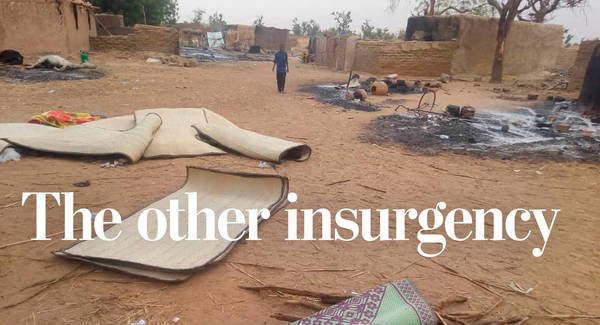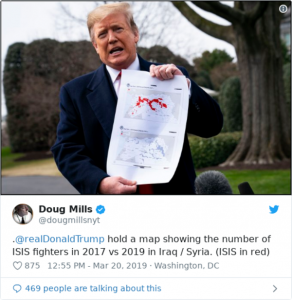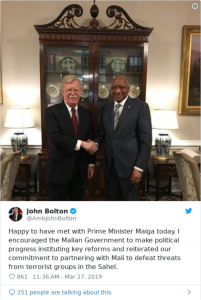
Published as “The Specter of Islamist Extremism Looms Over West Africa” in Friday, March 29th, 2019 edition of Today’s Worldview, a daily pullout from The Washington Post, (www.washingtonpost.com/news/worldviews), this is another insight into the seemingly ever widening national and regional insecurity crisis in West Africa - Intervention.
Last week, President Trump held up two maps before a group of reporters at the White House. One showed, in red, what territory the Islamic State purportedly controlled when Trump was elected more than two years ago. The other showed what he said the region looks like now.

As used in The Washington Post
He pointed out the only red spot left on the second map and said it would be “gone by tonight.” Soon after, the White House officially declared that the group’s “territorial caliphate has been eliminated in Syria.”
But thousands of miles away from the Islamic State’s stronghold in Syria and Iraq, a lesser-known epidemic of insurgency has upended the lives of millions of people. Throughout West Africa and the Sahel, violence is surging as a wide set of extremist groups, some with allegiances to the Islamic State and al-Qaeda, continue to target civilians and armed forces. They are infiltrating the region even as the influence of some powerful extremist groups wanes in the Middle East. Now, some experts and government officials fear that violence in such volatile hot spots may only increase.
Some even warn that the fall of the Islamic State could cause a flow of extremists to relocate to the Sahel, where vast desert regions, porous borders, corruption and proliferation of arms have created a perfect storm for extremists looking to exploit local populations.
In an interview with me and my colleague Danielle Paquette this week, Malian Prime Minister Soumeylou Boubèye Maïga said he feared that as groups such as the Islamic State weaken in the Middle East, it “could lead to a transfer of jihadists to the Sahel region.” And violence among local communities is rising as some civilians, fearing extremists, have begun to arm themselves.
Just days before Maïga landed in Washington, gunmen killed 157 people in a village in central Mali, in one of the deadliest attacks against civilians the country had experienced in years. An anti-extremism vigilante group is believed to have been behind the attack, which targeted the Fulani ethnic group, who are traditionally Muslim herders. Some extremists have recruited Fulani into their ranks in recent years, sparking tensions with other local communities, who in response have accused the herders of being sympathetic toward jihadists.
While in Washington this week, Maïga asked American officials to reinforce their assistance to Mali, as the country faces threats from a number of armed extremist groups who have taken advantage of insecurity and weak governance in the aftermath of a 2012-2013 uprising that destabilized much of the country. “The United States should have the same engagement in the Sahel as it does in the Middle East,” he said. “Malian security is the essential key to international security.”
Mali already learned the hard way what happens when extremist ideology takes root. In 2012, extremists linked to al-Qaeda took control of some of the country’s territory and implemented a harsh form of Sharia law. French forces eventually helped push them out in 2013, but groups that emerged in the aftermath of that conflict continue to terrorize the region.

As taken from The Washington Post
Mali is a prime example of “how all things could happen at once and spiral out of control,” Wendy Williams, an associate research fellow at the Africa Center for Strategic Studies in Washington, told Today’s WorldView. “You had a coup happen at the same time a separatist movement was happening in the north, and you had al-Qaeda in the Islamic Maghreb up in Algeria looking for a new place to get involved,” she said. Now, as the military struggles to contain various extremist threats, “it’s been easy for these groups to move in and start exploiting certain grievances" among the local population, Williams said.
As a result, violence has dramatically increased in the Sahel. The Armed Conflict Location & Event Data Project, a conflict monitoring group, recorded 4,776 fatalities in the region between November and March 23. Both incidents in which civilians were targeted and the number of civilians killed increased by about 50 percent compared with the same time period the year before, the group said.
Some of the most shocking data points come from Burkina Faso, where 499 people were killed in 124 incidents in that four-month period — a more than 7,000 percent increase compared with the previous year. In Mali, 547 deaths were recorded during that window, marking a more than 300 percent increase.
And the violence is surging at a time when the U.S. military is already planning to draw down some of its presence in Africa. The Wall Street Journal’s Joe Parkinson and Drew Hinshaw pointed out in February that as the Islamic State’s territory in Iraq and Syria shrank, a group known as the Islamic State West Africa Province began to take control of large swaths of territory in Nigeria. The group first emerged in 2016 after a split within the Boko Haram insurgency, which has ravaged the Lake Chad Basin since it first turned violent in 2009. About 2.5 million people are currently displaced across the region. But the newer group’s focus has veered away from attacks on civilians to focus more heavily on military and governmental targets.
“The picture that emerges — based on interviews with soldiers, refugees, intelligence officers, arms smugglers and diplomats in Nigeria and Niger, as well as to people who participated in talks with the faction — is of a well armed and motivated insurgent group that expects to establish a state out of strategic geography where the U.S. is dialing back its military presence,” Parkinson and Hinshaw wrote, highlighting the group’s apparent coordination with fighters who traveled to Libya and the Middle East.
National security adviser John Bolton outlined a new U.S. strategy in Africa in December that highlighted concerns about the threat of jihadists in the Sahel. But Africa continues to be somewhat of a blind spot for the Trump administration. And in an already unstable region, some groups seem ready and willing to take advantage of that.
Posted from my blog with SteemPress : https://intervention.ng/15614/
Source
Plagiarism is the copying & pasting of others work without giving credit to the original author or artist. Plagiarized posts are considered spam.
Spam is discouraged by the community, and may result in action from the cheetah bot.
More information and tips on sharing content.
If you believe this comment is in error, please contact us in #disputes on Discord
Hi! I am a robot. I just upvoted you! I found similar content that readers might be interested in:
https://www.washingtonpost.com/world/2019/03/29/specter-islamist-extremism-looms-over-west-africa/?noredirect=on